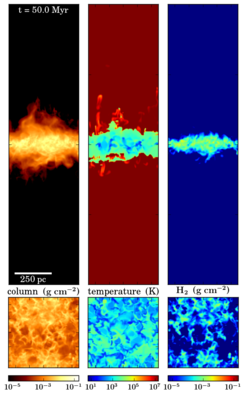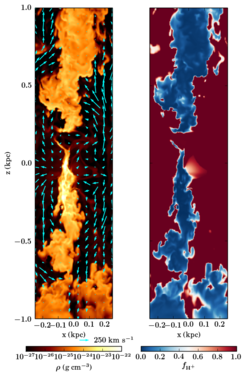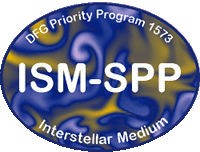How supernova explosions shape the interstellar medium and drive galactic outflows
With complex hydrodynamical simulations scientists at MPA investigate the detailed impact of supernova explosions on the chemical composition and the thermodynamic properties of the interstellar medium and galactic outflows.

Fig 1: Density (left), temperature (middle) and molecular gas distribution (right) in a simulation with supernovae exploding in dense regions. The upper, vertically extended, panels show the edge-on view with the disk in the mid-plane. In the lower panel we show the disk plane seen from above (face-on). The disk is compact, most of the gas is warm and diffuse and no outflows are launched. This is an unrealistic model for the observed multi-phase gas structure in real galaxies.
A supernova explosion is a most dramatic event at the end of a massive star’s life. Born in dense molecular clouds, massive stars evolve rapidly compared to cosmic timescales. At the end of their life – after several million to a few tens of million years – stars more massive than eight solar masses do not necessarily explode in the dense environment they were born. Some have travelled out of their parental cloud; some explode in low density cavities shaped by their own ionizing radiation and stellar winds or created by previous supernova explosions of nearby stars. The environmental density of a supernova explosion is very important. It determines the explosion impact on the ISM as well as the whole galaxy. An explosion in a dense environment means that the energy of the supernova shock is efficiently converted into radiation and escapes the galaxy. Therefore, the impact on the surrounding ISM is weak. If the explosion occurs in a low-density environment on the other hand, less energy is radiated away and the expanding remnant has more power left for heating and compressing the gas. This can lead to an enhanced production of hot gas but also of dense structures. The hot gas is driven out of the galactic disk and sweeps the colder ISM along.
The thermodynamic evolution of supernova remnants, the structure of their surrounding ISM and the efficiency of outflows are particularly important for the ecosystem of each individual galaxy. These factors play a fundamental role in regulating the gas content in each galaxy and thus the evolution of entire galaxy populations in the Universe. Explaining outflow properties and connecting simulated data to observations is therefore key to understanding the formation history of galaxies.

Fig 2: Chemical structure of the interstellar medium in a realistic simulation, where supernovae can also explode in low-density regions. The dense molecular gas (left) is assembled in clouds and filaments and embedded in diffuse neutral gas (right). The voids in between contain low-density gas heated to millions of Kelvin by supernova explosions.
Together with a European team of experts, scientists at MPA have used high-resolution supercomputer simulations to investigate the impact of supernova explosions on the ISM in a galactic disk. For the first time, the simulations follow not only the kinematics, densities and temperatures of the gas in the ISM but also the chemical transitions from ionized gas, over neutral atomic gas to dense molecular gas. The latter forms mostly on dust grains and can be destroyed by the interstellar radiation field and in strong shocks like those originating from supernova remnants.

Fig 3: Same representation as Fig. 1 but for a more realistic setup with supernovae exploding primarily in low-density regions. The explosions couple to the gas efficiently enough to induce large density contrasts, pushing gas out of the disk mid-plane (middle panels) and at the same time compressing gas into dense molecular clouds (right panel).
Assuming a typical supernova rate (up to a few dozen explosions in one million years) the team has investigated several possible scenarios for the location of supernova explosions. In Fig. 1 we show the simulated gas structure of the ISM in a galaxy after 50 million years of evolution, assuming that all supernovae explode in the densest regions of the gas where their progenitor stars were born. Explosions in dense regions inhibit the formation of further cold molecular clouds. The supernova shells loose their energy quickly and cannot efficiently accelerate gas or generate a hot, ionized medium. The result is an interstellar medium mainly made of warm neutral gas with small density contrasts and very few or no molecular clouds. In this configuration – which is not in agreement with observations of the ISM – no outflows are launched.
The situation changes dramatically if supernovae are allowed to explode in low-density environments. In this case the explosions generate a more realistic multi-phase medium, as shown in Fig. 2. Low-density regions are filled with hot ionized gas. Compared to observations this model is much more realistic. Fig. 3 shows the ISM structure for these models with supernova explosions in low-density regions. The ISM is more structured, filled with hot gas and much more extended out of the plane (in the vertical direction). At the same time the ISM develops dense molecular clouds, while the hot gas in the low density regions is expanding and drags diffuse neutral gas with it, forcing the gas to leave the galactic disk in a clumpy outflow. Fig. 4 shows more details on the outflows for such a model. The hot ionized gas is expanding from the disk mid-plane and reaches high velocities of several hundred kilometers per second. It escapes through low-density chimneys from the disk.

Fig 4: Outflow details showing the density (left) the degree of ionization (right) with blue indicating neutral gas and red indicating ionized gas. The density plot (right) also shows gas velocities (arrows). As in Fig. 1 and 3, the disk mid-plane is at the position z =0. The hot ionized gas expands quickly and escapes through low-density chimneys with velocities of several hundred km/s. The escaping gas drags low-density neutral gas with it.
To understand how supernova explosions impact the evolution of galaxies, it is crucial to investigate the structural details of the interstellar medium including the chemical composition, the distribution of gas, the positions of supernovae and the efficiency with which gas can escape a galaxy via outflows. The simulations of the SILCC collaboration are therefore an important step forward in understanding the regulation of potential star formation and the gas cycle in star-forming galaxies.
Philipp Girichidis and Thorsten Naab for the SILCC collaboration
Acknowledgement:

The SILCC project (Simulating the Life Cycle of molecular Clouds) is a supercomputing initiative of a group of European scientists to investigate the formation of molecular clouds, star formation and the impact of massive stars on parental cloud dispersal and the driving of galactic outflows. The team consists of Stefanie Walch, Dominik Derigs, Annika Franeck & Daniel Seifried (University of Cologne), Andrea Gatto, Philipp Girichidis, Thorsten Naab, Anabele Pardi & Thomas Peters (Max-Planck-Institute for Astrophysics), Simon Glover & Ralf Klessen (University of Heidelberg), Christian Baczynski (University of St Andrews), Richard Wunsch (Astronomical Institute of the Czech Academy of Sciences), Paul Clark (Cardiff University). Computations are performed at the Leibnitz Supercomputing Centre and the Max Planck Computing and Data Facility.
This work is supported by:

DFG Priority Program 1573: ISM-SPP

Max Planck Computing and Data Facility

Gauss Centre for Supercomputing





















